Alternative names Peuyeum Place of origin Nusantara | Type Alcoholic paste Created by Minangkabau ethnic | |
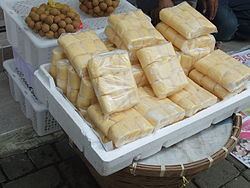 | ||
Similar Glutinous rice, Cassava, Bubur ketan hitam, Kue, Palm sugar | ||
How to make sabah tapai
Tapai (ta-pie) or tape (ta-peh), sometimes referred to as peuyeum (from Sundanese language), is a traditional fermented food found throughout much of East- and Southeast Asia. It is an alcoholic paste and has a sweet or sour taste and can be used directly as a food or in traditional recipes. Tapai can be made from a variety of carbohydrate sources, but typically from cassava, white rice, or glutinous rice. Fermentation is performed by a variety of moulds including Aspergillus oryzae, Rhizopus oryzae, Amylomyces rouxii or Mucor species, and yeasts including Saccharomyces cerevisiae, and Saccharomycopsis fibuliger, Endomycopsis burtonii and others, along with bacteria. Tapai is also used to make alcoholic beverages.
Contents
- How to make sabah tapai
- How to make tapai tape from fermented cassava
- Ragi Tapai
- Preparation
- Uses in cuisine
- Name of a place
- References
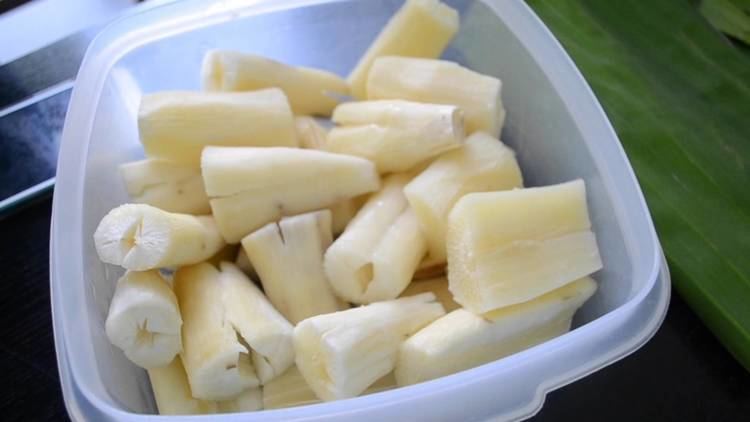
How to make tapai tape from fermented cassava
Ragi Tapai
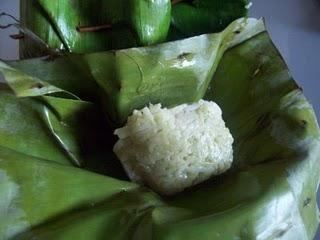
Tapai is made by inoculating a carbohydrate source with the required microorganisms in a starter culture. This culture has different names in different regions, shown in the table below. The culture can be naturally captured from the wild, by mixing rice flour with ground spices (include garlic, pepper, chili, cinnamon), cane sugar or coconut water, slices of ginger or ginger extract, and water to make a dough. The dough is pressed into round cakes, about 3 cm across and 1 cm thick, and left to incubate on trays with banana leaves under and over them for two to three days. They are then dried and stored, ready for their next use.
Preparation
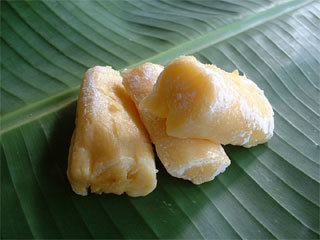
Ragi tapai is used to ferment different types of carbohydrates such as cassava, cooked white rice or glutinous rice, and sometimes sweet potatoes. The general process is to wash and cook the target food, cool to about 30°C, mix in some powdered ragi tapai, and rest in covered jars for one to two days. With cassava and sweet potato, the tubers are washed and peeled before cooking, then layered in baskets with ragi tapai sprinkled over each layer.
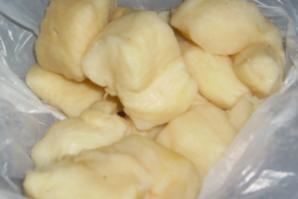
The finished tapai will taste sweet with a little alcohol, and can be consumed, or left for several days more to become sour.
Uses in cuisine
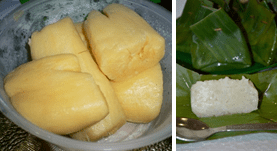
Tapai and its variants are usually consumed as it is; as a sweet mildly-alcoholic snacks, to accompany tea in the afternoon. The sweet fermented tapai however, are often used as the ingredient in a recipe of certain dishes. Sundanese cassava peuyeum is the main ingredient for colenak; a roasted fermented cassava tapai served with kinca a sweet syrup made of grated coconut and liquid palm sugar. Colenak is Sundanese portmanteau of dicocol enak which translates to "tasty dip". Tapai uli is a roasted block of bland-tasted ketan or pulut (glutinous rice) served with sweet tapai ketan or tapai pulut. The peuyeum goreng or tapai goreng, or known in Javanese as rondho royal is another example of Indonesian gorengan (assorted fritters), which is deep fried battered cassava tapai.
In beverages, tapai, both cassava or glutinous rice, might be added into sweet iced concoction desserts, such as es campur and es doger.
Name of a place
It is also being used as a name of a place, Wakaf Tapai in Terengganu Malaysia. The town is so named from the Malay words wakaf, meaning small hut for travelers resting, and the word tapai.
